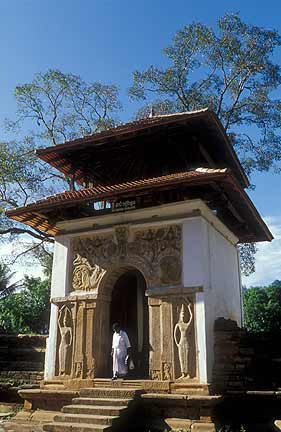
|
||||||||
|
| ||||||||
The Cult of God Natha
Not very much is known about the history of worship of God Natha. The name literally means ‘no form' and ‘no shape', and is therefore generally associated with the unknown Maitreya or Buddha to come. Natha was once considered a guardian deity of this island. We know this because in the third century when King Gajabahu returned after defeating the Choleans in South India, he held a grand procession to honour Natha and the other two guardian deities Vishnu and Skanda (Kataragama), who he claimed were responsible for his triumph. He added the Goddess Pattini as a new guardian deity to this procession, because he had been much taken with her cult when in India and had secured her golden anklets. The kings who followed Gajabahu continued this religious tradition. Mahayanist traditions during the fourth to tenth centuries gave Natha a special identity as the Bodhisatva Avalokiteswara, the most popular of the Buddhas to be. The Tissara Sandesa, a Sinhala poem in the 15th century, describes the image of Natha in a Buddha shrine at Dorawaka in the Kegalle District as having two arms like trunks of white elephants and exhibiting the splendour of a pair of streams flowing down the sides of a white mountain. This reference to a white image confirms the description of Avalokiteswara who is always represented in white. Then again at the Natha Dewala, Vesgiriya, off the Kandy to Gampola road, which is supposed to have been built in the time of the Gampola King Buvanakabahu IV (1341-1355), there are beautiful figures of god Natha and goddess Tara. And goddess Tara we know is the spiritual consort of Avalokiteswara. She is said to have sprung from his tears as he pondered the sufferings of humanity. It is very possible therefore that Natha was asssciated with the bodhisattva Avalokiteswara during the Mahayanist period. And that with the return to the Theravada traditions after Parakramabahu I, Natha came to be thought of as the Maitreya or Buddha to come. Certainly in the most famous Natha Dewala in Kandy, sited right opposite the Dalada Maligawa, Natha is known as the Maitreya. The gateway to the Devale premises is one of the most excellent pieces of Kandyan architecture found in Kandy today. It consists of a traditional double hipped roof and some good spirit sculptures under a makara arch. The Natha Dewala originally assumed leadership in the Kandy Esala Perahera. It was only in the 18th century, during the reign of King Kirti Siri Raja Simha, that the Maligawa procession was added to the annual pageant and became the dominant focus superceding the Natha Dewala and other dewala processions. When you look at the principal elephant in the Natha procession today, you will see that in the karanduwa he carries on his back there is a decorated sword to remind us that this procession originated as a victory pageant of war. This same symbol has been used to signify victory in war as well. The insignia of the sword is also a reminder that the Natha Dewala played an important role in the inauguration ceremony of the Kandyan kings. A new king had to be given a name before he had the sword of state girded on him. The ‘naming' and ‘girding' ceremony was carried out at the Natha Dewala, Kandy. It was the duly of the royal astrologers to choose a fortunate (necath) period and a fortunate name for the king. Each name was written on a gold plate set with precious stones and deposited in the Dewala. On the ‘necath' day declared by the astrologers the king would go to the Natha Dewala and make the necessary religious offerings. Then he would choose a name. The chosen name would be loudly proclaimed by the First Adigar and then bound to the king's forehead. Next the sword of state, having received the blessings of Natha, would be girt to the belt in the king's waist. Backed by the grace of the Buddha to be, the king was now ready to serve his people as their defender and their ‘Solomon' of justice. by Derrick Schokman See also "Yatinuwara Dodanwala Esala Perahera" from The Sunday Island of 7 September 2003.
|
